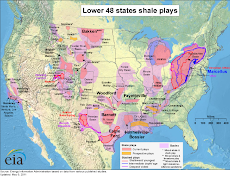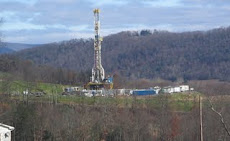There's an energy revolution brewing right under our feet.
Journal Report
Read the complete Energy report .
Read More
Tapping the Gas
See how horizontal drilling and hydraulic fracturing work.
Over the past decade, a wave of drilling around the world has uncovered giant supplies of natural gas in shale rock. By some estimates, there's 1,000 trillion cubic feet recoverable in North America alone—enough to supply the nation's natural-gas needs for the next 45 years. Europe may have nearly 200 trillion cubic feet of its own.
We've always known the potential of shale; we just didn't have the technology to get to it at a low enough cost. Now new techniques have driven down the price tag—and set the stage for shale gas to become what will be the game-changing resource of the decade.
I have been studying the energy markets for 30 years, and I am convinced that shale gas will revolutionize the industry—and change the world—in the coming decades. It will prevent the rise of any new cartels. It will alter geopolitics. And it will slow the transition to renewable energy.
To understand why, you have to consider that even before the shale discoveries, natural gas was destined to play a big role in our future. As environmental concerns have grown, nations have leaned more heavily on the fuel, which gives off just half the carbon dioxide of coal. But the rise of gas power seemed likely to doom the world's consumers to a repeat of OPEC, with gas producers like Russia, Iran and Venezuela coming together in a cartel and dictating terms to the rest of the world.
![[EYCOVER]](http://si.wsj.net/public/resources/images/EY-AA329_EYCOVE_DV_20100507120925.jpg) John Gould/The Wall Street Journal
John Gould/The Wall Street Journal The advent of abundant, low-cost gas will throw all that out the window—so long as the recent drilling catastrophe doesn't curtail offshore oil and gas activity and push up the price of oil and eventually other forms of energy. Not only will the shale discoveries prevent a cartel from forming, but the petro-states will lose lots of the muscle they now have in world affairs, as customers over time cut them loose and turn to cheap fuel produced closer to home.
The shale boom also is likely to upend the economics of renewable energy. It may be a lot harder to persuade people to adopt green power that needs heavy subsidies when there's a cheap, plentiful fuel out there that's a lot cleaner than coal, even if gas isn't as politically popular as wind or solar.
But that's not the end of the story: I also believe this offers a tremendous new longer-term opportunity for alternative fuels. Since there's no longer an urgent need to make them competitive immediately through subsidies, since we can use natural gas now, we can pour that money into R&D—so renewables will be ready to compete without lots of help when shale supplies run low, decades from now.
To be sure, plenty of people (including Russian Prime Minister Vladimir Putin and many Wall Street energy analysts) aren't convinced that shale gas has the potential to be such a game changer. Their arguments revolve around two main points: that shale-gas exploration is too expensive and that it carries environmental risks.
I'd argue they are wrong on both counts.
Take costs first. Over the past decade, new techniques have been developed that drastically cut the price tag of production. The Haynesville shale, which extends from Texas into Louisiana, is seeing costs as low as $3 per million British thermal units, down from $5 or more in the Barnett shale in the 1990s. And more cost-cutting developments are likely on the way as major oil companies get into the game. If they need to do shale for $2, I am willing to bet they can, in the next five years.
When it comes to environmental risks, critics do have a point: They say drilling for shale gas runs a risk to ground water, even though shale is generally found thousands of feet below the water table. If a well casing fails, they argue, drilling fluids can seep into aquifers.
They're overplaying the danger of such a failure. For drilling on land, where most shale-gas deposits are, the casings have been around for decades with a good track record. But water pollution can occur if drilling fluids are disposed of improperly. So, regulations and enforcement must be tightened to ensure safety. More rules will raise costs—but, given the abundance of supply, producers can likely absorb the hit. Already, some are moving to nontoxic drilling fluids, even without imposed bans.
Getty Images A pipeline being built to carry Russian natural-gas exports to Western Europe.
But the skeptics aren't just overstating the obstacles. They're missing two much bigger points. For one thing, they're ignoring history: The reserves and production of new energy resources tend to increase over time, not decrease. They're also not taking into account how quickly public opinion can change. The country can turn on a dime and embrace a cheaper energy source, casting aside political or environmental reservations. This has happened before, with the rapid spread of liquefied-natural-gas terminals over the past few years.
In short, the skeptics are missing the bigger picture—the picture I think is the much more likely one. Here's a closer look at what I'm talking about, and how I believe the boom in shale gas will shake up the world.
One of the biggest effects of the shale boom will be to give Western and Chinese consumers fuel supplies close to home—thus scuttling a potential natural-gas cartel. Remember: Prior to the discovery of shale gas, huge declines were expected in domestic production in U.S., Canada and the North Sea. That meant an increasing reliance on foreign supplies—at a time when natural gas was becoming more important as a source of energy.
Even more troubling, most of those gas supplies were located in unstable regions. Two countries in particular had a stranglehold over supply: Russia and Iran. Before the shale discoveries, these nations were expected to account for more than half the world's known gas resources.
Russia made no secret about its desire to leverage its position and create a cartel of gas producers—a kind of latter-day OPEC. That seemed to set the stage for a repeat of the oil issues that have worried the world over the past 40 years.
As far as I'm concerned, you can now forget all that. Shale gas will breed competition among energy companies and exporting countries—which in turn will help economic stability in industrial countries, and thwart petro-suppliers that try to empower themselves at our expense. Market competition is the best kryptonite for cartel power.
For one measure of the coming change, consider the prospects for liquefied natural gas, which has been converted to a liquid so it can be carried in a supertanker like oil. It's the easiest way to move natural gas very long distances, so it gives a good picture of how much countries are relying on foreign supplies.
Before the shale discoveries, experts expected liquefied natural gas, or LNG, to account for half of the international gas trade by 2025, up from 5% in the 1990s. With the shale boom, that share will be more like one-third.
In the U.S., the impact of shale gas and deep-water drilling is already apparent. Import terminals for LNG sit virtually empty, and the prospects that the U.S. will become even more dependent on foreign imports are receding. Also, soaring shale-gas production in the U.S. has meant that cargoes of LNG from Qatar and elsewhere are going to European buyers, easing their dependence on Russia. So, Russia has had to accept far lower prices from formerly captive customers, slashing prices to Ukraine by 30%, for instance.
But the political fallout from shale gas will do a lot more than stifle natural-gas cartels. It will throw world politics for a loop—putting some longtime troublemakers in their place and possibly bringing some rivals into the Western fold.
Again, remember that as their energy-producing influence grew, nations like Russia, Venezuela and Iran became more successful in resisting Western interference in their affairs—and exporting their ideologies and strategic agendas through energy-linked deal-making and threats of cutoffs.
In 2006 and 2007, disputes with Ukraine led Russia to cut off supplies, leaving customers in Kiev and Western Europe briefly without fuel in the dead of winter. That cutoff effectively shifted Ukraine's internal politics: The country turned away from the pro-NATO, anti-Moscow candidate and toward a coalition more to Moscow's liking.
It looked like the U.S. and Europe would see their global power eclipse as they kowtowed to their energy suppliers. But shale gas is going to defang the energy diplomacy of petro-nations. Consuming nations throughout Europe and Asia will be able to turn to major U.S. oil companies and their own shale rock for cheap natural gas, and tell the Chavezes and Putins of the world where to stick their supplies—back in the ground.
Bloomberg News Blades of wind turbines going up near Milford, Utah.
Europe, for instance, receives 25% of its natural-gas supply via pipelines from Russia, with some consumers almost completely dependent on the big supplier. In the wake of Russia's strong-arming of Ukraine, Europe has been actively diversifying its supply, and shale gas will make that task cheaper and easier.
Shale-gas resources are believed to extend into countries such as Poland, Romania, Sweden, Austria, Germany—and Ukraine. Once European shale gas comes, the Kremlin will be hard-pressed to use its energy exports as a political lever.
I would also argue that greater shale-gas production in Europe will make it harder for Iran to profit from exporting natural gas. Iran is currently hampered by Western sanctions against investment in its energy sector, so by the time it can get its natural gas ready for export, the marketing window to Europe will likely be closed by the availability of inexpensive shale gas.
And that may lead Tehran to tone down its nuclear efforts. Look at it this way: If Iran can't sell its gas in Europe, what options does it have? Piping to the Indian subcontinent is impractical, and LNG markets will be crowded with lower-cost, competing supplies.
It's admittedly a long shot, but if the regime acts rationally, it will realize it has a chance to win some global goodwill by shifting away from nuclear-power efforts—and using its cheap natural-gas supplies to generate electricity at home.
Overall, the Middle East might get a bit poorer as gas eats into the market for oil. If the drop in revenue is severe enough, it could bring instability.
Shale-gas development could also mean big changes for China. The need for energy imports has taken China to problematic nations such as Iran, Sudan and Burma, making it harder for the West to forge global policies to address the problems those countries create. But with newly accessible natural gas available at home, China could well turn away from imports—and the hot spots that produce them.
The less vulnerable China is to imported oil and gas, the more likely it would be to support sanctions or other measures against petro-states with human-rights problems or aggressive agendas. Moreover, the less Beijing worries about U.S. control of sea lanes, the easier it will be for the U.S. and China to build trust. So, domestic shale gas for China may help integrate Beijing into a Pax Americana global system.
With natural gas cheap and abundant, the prospects for renewable energy will change just as drastically. I have been a big believer that renewable energy was about to see its time. Prior to the shale-gas revolution, I thought rising hydrocarbon prices would propel renewables and nuclear power into the marketplace easily—albeit with a little shove from a carbon tax or a cap-and-trade system.
But the shale discoveries complicate the issue, making it harder for wind, solar and biomass energy, as well as nuclear, to compete on economic grounds. Subsidies that made renewables competitive with shale gas would get more expensive, as would loan guarantees and incentives for new nuclear plants. Shale gas also hurts the energy-independence argument for renewables: Shale gas is domestic, just like wind and solar, so we won't be shipping those dollars to the Middle East.
But that doesn't mean we should stop investing in renewables. As large as our shale-gas resources are, they're still exhaustible, and eventually we will still need to transition to energy that is cleaner and more plentiful. So, what should we do?
First, avoid the urge to protect coal states and let cheaper natural gas displace coal, which accounts for about half of all power generated in the U.S. Ample natural gas for electricity generation could also make it easier to shift to electric vehicles—once again helping the environment and lessening our dependence on the Middle East.
Then, I think we still need to invest in renewables—but smartly. States with renewable-energy potential, such as windy Texas or sunny California, should keep their mandates that a fixed percentage of electricity must be generated by alternative sources. That will give companies incentives and opportunities to bring renewables to market and lower costs over time through experience and innovation. Yes, renewables may seem relatively more expensive in those states as shale gas hits the market. And, yes, that may mean getting more help from government subsidies. But I don't think the cost would be prohibitive, and the long-term benefits are worth it.
Still, I don't believe we should set national mandates—which would get prohibitively expensive in states without abundant renewable resources. Instead of pouring money into subsidies to make such a plan work, the federal government should invest in R&D to make renewables competitive down the road without big subsidies.
***
In the end, what's important to understand is that shale gas may be the key to solving some of our most pressing short-term crises, a way to bridge the gap to a more-secure energy and economic future.
The trade deficit has crippled our economy and shows no signs of abating as long as we remain tethered to imported energy. Why ship dollars abroad where they can destabilize global financial markets—and then hit us back in lost jobs and savings—when we can develop the resources we have here in our own country? Shall we pay Vladimir Putin and Mahmoud Ahmadinejad to develop our natural gas—or the citizens of Pennsylvania and Louisiana?
Ms. Jaffe is the Wallace S. Wilson Fellow for Energy Studies at the James A. Baker III Institute for Public Policy at Rice University and co-author of "Oil, Dollars, Debt and Crises: The Global Curse of Black Gold." She can be reached at reports@wsj.com.
Correction & Amplification:
Natural gas from a working well flows directly through a pipeline system to a processing facility, and then on to consumers through other pipeline systems. A diagram of a shale-gas well in an earlier version of this article.


![[CHEAPGAS]](http://sg.wsj.net/public/resources/images/OB-IK741_CHEAPG_D_20100507125802.gif)
![[EYCOVER]](http://si.wsj.net/public/resources/images/EY-AA329_EYCOVE_DV_20100507120925.jpg) John Gould/The Wall Street Journal
John Gould/The Wall Street Journal 

![[CHEAPGASchart]](http://sg.wsj.net/public/resources/images/EY-AA354A_CHEAP_NS_20100507130002.gif)




